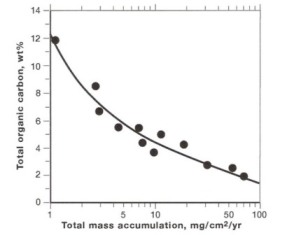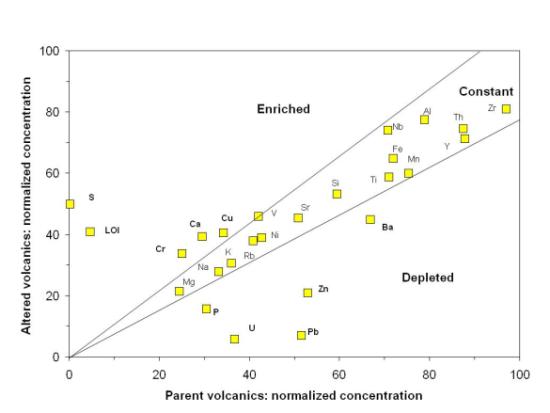Cold seep barite - Palos Verdes CA

The Southern California Continental Borderland is an area dominated by strike-slip fault motion, which has produced a series of alternating deep basins with intervening highs. Some of the basins are offshore (e.g. the Santa Barbara Basin) and some are onshore (e.g. the Los Angeles Basin). The Palos Verdes peninsula is an uplifted blocks situated between the LA Basin and the San Pedro Basin.

Mudstone Host
The barite mineralization exposed at Palos Verdes is hosted by both the Monterey Formation and its associated basalts. The Monterey here is divided into the Altamira Shale Member (about 300 m thick), followed by the Valmonte Diatomite (125 m) and then the Malaga Mudstone (125 m). It unconformably overlies the Mesozoic Catalina Schist. The Altamira is itself subdivided into a tufface ous, a cherty, and a phosphatic lithofacies.
ous, a cherty, and a phosphatic lithofacies.
In the Monterey, as in other black shales, organic content and rate of deposition are linked. High organic carbon contents in the sediment are strongly correlated to slow net sedimentation. In the modern offshore basins of California, bottom water is low in oxygen, but does not contain free H2S. Piper and Isaacs (1995b; 2001) have concluded that during the Miocene, when the Monterey was deposited, that basins were similarly low in oxygen, but were not euxinic.
The Monterey has experienced extensive diagenetic alteration, which includes conversion of volcanic glass to smectite, conversion of opaline silica to microcrystalline quartz, and precipitation of dolomite. Proximity to the basaltic sills appears to accelerate these changes. Beds of calcitic mudstones converted to dolostone are widespread, but dolomitic beds formed by replacement and cementation of non-calcareous precursors are characteristic of zones near the basaltic intrusions.
Volcanic Rocks
Miocene volcanic rocks are widely distributed in offshore and onshore southern California. Successively landward, they can be divided into seamounts; the Channel Islands; and onshore areas such as Canejo and Palos Verdes. At Palos Verdes, highly altered basalts are exposed at the foot of the sea cliffs [chemistry data tables]. The alteration trends for the Palos Verdes samples, as visualized using the isocon method of Grant (1986; 2005), show enrichments in S, H2O and perhaps Ca; constancy for Ti, Al, Nb, Th, Ti, Y, Zr and others; and depletion in Ba, Pb, Zn, P, and U. The strong enrichment in S seen in the diagram, which thin-section analysis indicates is predominately pyrite, suggests that seawater penetrated the volcanic pile deeply and added S through thermochemical sulfate reduction. At the same time, Ba, Pb, and Zn were removed.

If we compare the ratios of resistate elements, it can be seen that the Palos Verdes volcanics plot in a completely separate field from other barite deposits, offering hope that this set of elements would be a useful discriminator.

Isotopes
Barite chemistry from the Palos Verdes veins shows nearly pure BaSO4 with little dilution by silica and no Pb or Zn, unlike hydrothermal barites such as Red Dog. Also in contrast to Red Dog, sulfur isotopes (see table) are much heavier than seawater, indicating closed-system bacterial sulfate reduction within the sediment pile. Pyrite in the altered basalts is about 8 permil, again too heavy for open-system bacterial sulfate reduction.
Sr isotopes are non-radiogenic and the 87/86 ratio is slightly lower than modern or Miocene seawater. Sr isotopes in the vein barites average 0.70834 whereas dolomite veins are 0.70838. These lower values suggest that some Sr from the underlying basalts, which would have ratios of about 0.7035 based on values from the Canejo Volcanics (Weigand et al., 2002), is incorporated in the veins at Palos Verdes.
| S and Sr Isotopic composition of selected barite samples and host rocks from the Southern California Continental Borderland (Hein et al. 2007) | ||||
| n | δ34SCDT ‰ | 87Sr/86Sr | Δ87Sr/86Sr | |
| Onshore Miocene deposits | ||||
| Barite veins | 8 | 64 | 0.708336 | -0.00084 |
| Dolomite veins | 2 | 0.708383 | -0.00079 | |
| Pyrite in altered basalt | 10 | 7.8 | -- | |
| Pyrite in Monterey Fmn | 3 | 2.2 | -- | |
| Offshore modern deposits | ||||
| Modern barite | 7 | 43.8 | 0.708432 | -0.00074 |
| Modern seawater | 0.709175 | |||
The suite of isotopes found at Palos Verdes is most similar to modern cold-seep barites from strike-slip settings (see Isotopes in Modern Barite Deposits).
Ore Deposits Home |
Barite references |
Site Map |
|---|